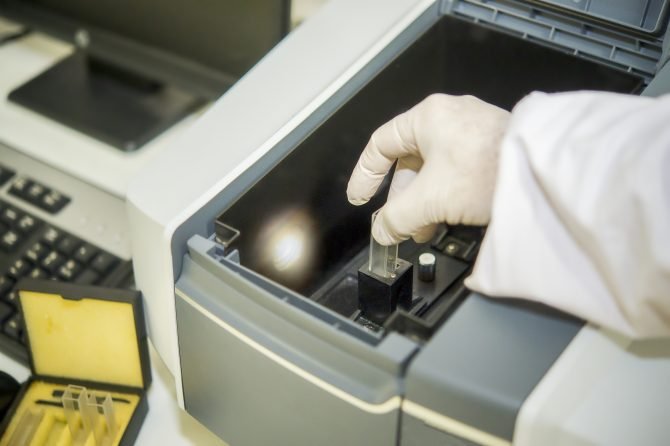Last Updated on July 18, 2024 by Ali Hamza
UV-VIS spectroscopy is one of the most common techniques used in chemistry. It uses light to measure the energy and wavelength of a sample. This information can then be used to determine the structures and properties of molecules. In this post, we’ll take a look at how does UV-VIS spectroscopy works and some of its applications.
Table of Contents
What is UV vis spectroscopy and what does it do?
UV-visible spectroscopy (UV-vis) is an analytical technique used to determine the concentrations of chemicals in a solution. It works by measuring the absorbance of light at different wavelengths as it passes through a sample. The amount of light absorbed is proportional to the concentration of the chemical in the sample. As such, UV-vis spectroscopy can be used to quantitatively analyze a wide range of compounds, including metals, inorganic molecules, and even biomolecules such as DNA and proteins. Additionally, UV-vis spectroscopy can be used to study the kinetics of chemical reactions and to determine the binding constants of molecular interactions. Ultimately, this versatile technique provides scientists with valuable insights into the behavior of chemicals at both the macroscopic and microscopic levels.
How does the equipment work and what are the benefits of using it in research and development labs across the globe?
The equipment is state of the art and helps with research and development for labs across the globe. The benefits are that it is exact and can do a lot of things that other machines can do. It also is bi-directional so it can be used in many different ways. Additionally, this machine is more affordable than some of the other options on the market.
What industries make use of UV vis spectroscopy and how has it helped to improve their products or services?
UV vis spectroscopy is a widely used analytical technique that can provide information about the composition of a sample. It is used in various industries, including cosmetics, pharmaceuticals, and food and beverage. In the cosmetics industry, UV vis spectroscopy is used to analyze the SPF of sunscreens and the stability of colorants. In the pharmaceutical industry, it is used to identify active ingredients in drug formulations and to monitor the stability of drugs during storage. In the food and beverage industry, it is used to analyze the vitamin C content of fruits and vegetables and to monitor the shelf life of packaged foods. UV vis spectroscopy has helped improve the quality and safety of products in these industries by providing accurate information about their composition.
Who are some of the top researchers in this field and what have they discovered about how this technology can be used to benefit society as a whole?
Some of the top researchers in nanotechnology are working on ways to use this technology to benefit society as a whole. One area of research is focused on developing new materials that are stronger and more durable than traditional materials. These new materials could be used to build better homes, bridges, and other structures. Another area of research is focused on using nanotechnology to create new medical treatments. For example, scientists are working on ways to use nanoparticles to deliver drugs directly to cancer cells. This could potentially simplify cancer treatment and reduce side effects. Additionally, researchers are exploring ways to use nanotechnology to clean up the environmental pollution. For instance, scientists are working on ways to develop nano-sized filters that can remove heavy metals and other pollutants from water supplies. Overall, the potential applications of nanotechnology are vast and researchers are just beginning to scratch the surface of what is possible.
How will UV vis spectroscopy continue to evolve over time and what impact will it have on scientific discovery?
UV vis spectroscopy is a powerful tool that scientists use to study the Universe. By measuring the light emitted by objects in space, spectroscopists can learn about their composition, temperature, and motion. In recent years, UV vis spectroscopy has undergone a major transformation, thanks to advances in technology. New telescopes and detectors have allowed astronomers to measure light at wavelengths that were previously invisible to us. As a result, we have been able to make discoveries that would have been impossible just a few years ago. For example, we have found evidence for water on Mars and discovered hundreds of new exoplanets. In the future, UV vis spectroscopy will continue to evolve, providing astronomers with ever-greater insights into the Cosmos.
Read more: The Benefits Of CyberUnlocked And Vulnerability Testing
Conclusion:
UV vis spectroscopy is a type of spectroscopy that uses ultraviolet light to measure the properties of a sample. -UV vis spectroscopy can be used to determine the concentration of a substance in a sample, as well as its optical properties. -UV vis spectroscopy is often used in research and quality control applications. Have you ever wondered how UV vis spectroscopy works? This post has hopefully given you a basic understanding of how this powerful tool operates. Keep an eye out for future posts where we’ll discuss some specific applications of UV vis spectroscopy!
Apart from that if you want to know about Enhanced Customer Service with GPS Tracking then please visit our Technology category













